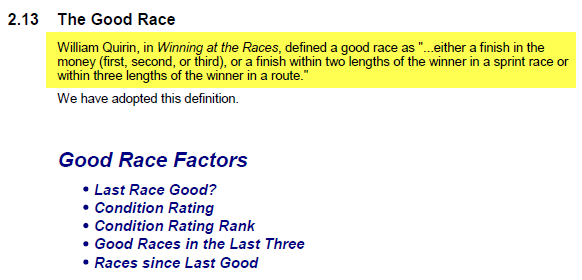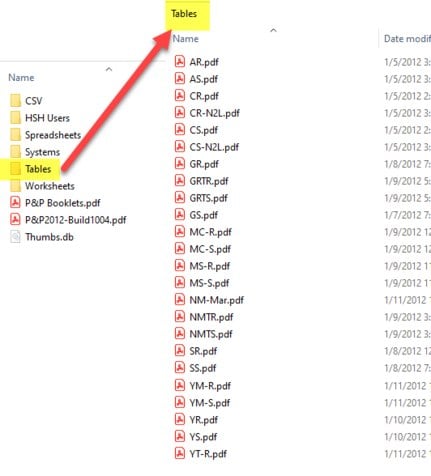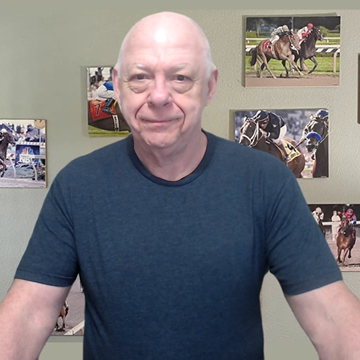-
Turn TimesShould I wait a little longer for the 2022 version of P&P ? — William Zayonce
If you buy it now, I'll just give you a full credit towards the new one when it is available. -
Turn TimesOk, I got you...so it's a little bit of manual estimation to get your actual turn times. That makes sense, was just making sure there wasn't some awesome set of turn data out there I wasn't aware of. — Dustin Korth
Well, there is in our software.
We see all the numbers as having 4 distinct fractions and the ratings attached to them.
I'm currently working on Percentages & Probabilities 2022, which will be available before Christmas. After that, my next publication will contain some high-level pace analysis materials that addresses factors and their potential value as a predictor.
Can't overdue those stats from a global perspective, though, because they are likely to change across track-surface-distance-pace shape. -
Turn TimesI have been looking at the actual internal fraction around the turn. — Jim Chiamardas
That's how I see it as well.
Just wanted to make sure I understood. -
Turn Times
Do you define "turn time" as the 4f time in a 6 furlong race or is it the actual fractional time from 1st call to 2nd call? -
Anything Better than APV or EPS for a Class Rating?If you want to see an interesting analysis of Expected Performance Last Start vs Actual Performance This Start see https://www.betfair.com.au/hub/importance-of-previous-starting-prices/
The analysis relates to Australian racing and the article is on Betfair Australia site. Let me know if you can't access it. — John Rosier
That is an excellent article!
A bit more in-depth than the one I read on Sky Racing.
Thank you. -
WHALES: A little back story Part 1
I'm not familiar with Harbour so I looked it up.
That is certainly NOT the dBase-Clipper -FoxPro-type of language software from the '80s. LOL
Wonderful to see that those old database engines are still supported.
Is the old CODE supported as well? -
Anything Better than APV or EPS for a Class Rating?I would be interested in what you learnt about the Australian approach. Can you share it? — John Rosier
A couple of very cool ideas.
First, understand that the AUS PPs are just... lacking. What we take for granted in the depth and quality of data is literally like 50x what the AUS punters have!
When working with the AUS guys I was able to get their data. Would you believe that what we get for (say) $125 per month would cost over $3,000 over there - and would still be like 1/3 of ours!
So, when I say, that I learned some good stuff, I don't mean that it is readily available.
So, here's some cool ideas that I will be adding to our stuff.
RAN WELL
Think of it as sort of like Quirin's "Good Race."
Ran 1st,2nd,3rd
or
Within 2 lengths (3 lengths in a route)
But, instead, they measure it in lengths behind the winner.
EXPECTED TO RUN WELL
Imagine a table that has 2 columns.
- 1st column is ODDS.
- 2nd column is lengths behind
Now imagine that the Lengths Behind column represents the Average Lengths Behind for a horse in each of the given odds ranges.
Thus, one can look at a horse that is 5/2 and say that HE SHOULD RUN WITHIN 2.3 LENGTHS.
(Not the actual number.)
Imagine having that for each odds range.
CORRELATING ODDS TO LENGTHS & BACK
The upshot of this is that a particular performance (i.e. beaten lengths) can now be graded as "He ran like 2/1" or "He ran like 12/1."
Of course, the class levels are another cool thing, but I will leave that for another day. -
WHALES: A little back story Part 1But on a FoxPro note. My software, which I do not share or sell, is written in Harbour, another dBase offshoot that had Clipper as the in-between. Any half-way decent language can make horse race calculations. While I don't claim to be the greatest handicapper around, I do well enough to post my selections online nearly every day. The cool part is that I can make any modification I want at any time I want. — RanchWest
Indeed.
I, too, used dBase & Clipper.
They do a fine job of programming.
However, historically, they process painfully slowly because they're scripting languages.
The very idea that an organization that is betting millions of dollars would use anything but the fastest, cutting edge tools is shocking.
But my real point was that I'd never understood why all those Asian & AUS groups used FoxPro - until that time in 2002 when I got Benter's code.
He literally invented the whales' basic system by doing it first and then provided everyone else with the tools to compete! Of course, they were always behind the curve - his curve - until the big budget guys entered the picture.
BTW, any discussion of Bill Benter would be incomplete without mentioned this guy - Alan Woods (gambler). -
Late Odds ChangesSo...someone already possessing such a winning system could conceivably syndicate it to generate startup and bankroll ... — William Zayonce
This is a common misconception.
The whales are not "syndicates."
A syndicate implies that a bunch of guys got together and decide upon picks or strategies. That is just not how they work.
The game they play is just too difficult for that type of operation.
These are businesses.
They start with a plan to figure it out, which takes experts. A "quant" (at $20-$30k per month) is usually at the core, coders to write software, analysts to test & track the output of the current system(s) in play, as well as the actual bet makers - usually called "analysts" as well.
Nobody makes any kind of decision. The software must do it all.
In order to play at that level (i.e. bet $100m per year minimum) one has to play
- play 7 days a week
- 80% of tracks on each day
- 80% of races at each track
- 80% of the pools in those races
When I was involved with a small (by comparison) operation, it took 15 people (minimum) on the schedule to fill all the shifts. Small days you can get by with 2 (one race analyst and one supervisor) but on weekends it takes a minimum of 4 and a supervisor to make it work.
In other words, it is not a trivial operation. -
Late Odds ChangesMinimum start up is typically $450,000 in infrastructure & development before bankroll.
Most such corporations never make their first bet because they can't build a winning system. -
Late Odds Changes
Nothing to forgive.
Sorry if my message was not worded properly.
The point is that these are viable business entities.
While they are small potatoes in the world of corporations, they are huge in our industry. -
Late Odds Changes
Seriously?
One company wagered $300m and made $27m profit.
That's a +9% ROI.
But even more amazing is that they did it out of a $3m bankroll.
Thus, that is 9x on their money for the year.
They have 100 employees. -
Late Odds ChangesThanks for this interesting stat Dave! Im not so sure that the "Whales" were in action when I last played daily a decade ago.Since 2019 I've only played sporadically and selectively.Perhaps that's why I didn't recognize the pattern . — William Zayonce
They've been playing since around 2005, but their betting approaches all changed about 2014/15.
They used to feed the money in gradually, so as to not disturb things, but then changed to an "when the first horse loads."
Remember that $1.00 out of every $6.50 wagered in North America comes from SIX companies. -
Late Odds Changes& @William Zayonce,
My position is that depending upon the tote board makes me crazy.
I've adopted the practice of betting into PROJECTED ODDS.
This works so well that I only use the tote board as a last minute check for HIGH ODDS horses that SHOULD BE LOW ODDS.
Coming before Christmas is a tool that will allow all of you to let go of your dependence on the tote board.
I really need to build a sticky thread called, "What I'm working on NOW & SOON." -
Late Odds ChangesIt goes both ways . I take the position that I can't control the odds so just accept what I get or pass. — William Zayonce
Alas, it doesn't go "both ways" very often.
We bet on what I call "Gate Odds" but get paid on "Winner Circle Odds".
If the winners odds went up even remotely close to how often they go down, then it would GO BOTH WAYS.
However, the winners' GATE ODDS actually GO DOWN 74% of the time!!! -
Finding out what winsTwo examples of simple "angles" that I like are these; "1 : the only entrant to win its last race ( combined with a few "complemenary " factors) ."2 : the only entrant to finish 2nd or "good" race ( again with qualifications). — William Zayonce
Interesting approach to spot plays.
I have a project on my agenda for the spring which is called Subset Handicapping.
It begins with a subset of horses and asks the question "What makes ________ horses win?"
My concern about your current approach is that these angles you mention above are just not as exciting as you'd think.
I know you have tacked on some other conditions to your angle but the bottom line is that the difference between "Good Race Last = YES" and "Good Race Last = NO" is really negligible. Sure, the IV & hit rate is higher but it does almost nothing for the $net ($2 is break even) because the gains are destroyed by the huge downward tick in the average odds .
(from P&P, 2012)

-
Finding out what winsHow would you define a good race? — Steven
Standard definition is from Dr. William Quirin (found in Percentages & Probabilities.)

-
Finding out what winsIf these stats are already included in "Percentages and probabilities " please advise, I'll order a copy. — Zayonce William
Good races and some other stuff are in PAST 10 and a bunch of items in LAST 90 DAYS are included.
There are HUNDREDS of factors.
There are also those SAME HUNDREDS of factors (data tables) spread across 25 different kinds of races. Over 1,300 extra pages!
Buy it here.

- Allowances Sprints & Routes
- Claiming Sprints & Routes (including N2L)
- Graded Sprints, Routes, Turf
- Maidens, etc.
- Young Horses
- Marathons
-
Finding out what winsHighest QES points percentage (of field total) might be interesting. — Zayonce William
Surprisingly, that is a very disappointing factor.
Check out the Early Speed series, if you haven't already.
You have to see it from an "out-perform the tote board" point of view.How much of an advantage ( in percentage) is needed to produce a profitable play. — Zayonce William
If you've not read this book, Percentages & Probabilities, there is a lot in it like that.
Dave Schwartz

Start FollowingSend a Message


